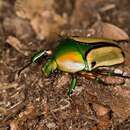Comprehensive Description
provided by EOL authors
Rose chafers, sometimes called flower chafers or flower beetles,(1,2) are a group of about 3600-3900 scarab beetle species(1,2,3) that live practically all over the world,(1,4) though with the highest diversity in tropical forests.(1) These beetles are known for their striking colors, often bright with a glittering, metallic appearance,(3,4) and have a huge size range, from the massive Goliath beetle (at over 11 centimeters in length, one of the world’s largest beetles) to the tiny beetles of the subfamily Valginae which are no more than a few millimeters long.(3) In addition to their overall diversity, rose chafers have a very high degree of endemism, meaning that types found in one place are found nowhere else; this is the case for about 90% of rose chafer genera.(1) Despite their widely-varying appearance, the vast majority of rose chafers (specifically all those in the very large subfamily Cetoniinae) share a feature called a posthumeral elytral emargination.(1,3) This is a change in the structure of the elytra (the hard, strong forewings that protect the more delicate alae, or hind wings, when the alae are folded (5,6)) which allows the alae to poke out and unfold without the elytra opening all the way.(1,5,6) This adaptation enables most rose chafers to fly particularly fast.(1) Various kinds of rose chafers have a large number of other special adaptations as well. For example, while most adult rose chafers feed on pollen, nectar, plant sap, and fruits,(1,2,3,7) some have adapted to prey on ant larvae,(3) while some rose chafer larvae live with insects(3) or even vertebrates such as birds of prey and feed on the material that collects in their nests.(8) Some rose chafers serve as pollinators(4,9) and so they are sometimes beneficial to plants, but several members of this beetle group are noted pests of flowers(1) such as roses(6) and fruit crops(1,4) such as peaches.(7)
Introduction
provided by EOL authors
Rose chafers, sometimes called flower chafers or flower beetles,(1,2) are a large group of scarab beetles known for their striking colors; they are often bright with a glittering, metallic appearance.(3,4) They have a huge size range, from the massive Goliath beetle—at over 11 centimeters in length, one of the world’s largest beetles—to the tiny species of the subfamily Valginae which are no more than a few millimeters long.(3) This beetle family is so diverse that it contains some 3,600-3,900 species(1,2,3) spread out across the globe(1,4) (although especially in tropical forests(1)), with most of them being endemic (found in only one place).(1) Yet despite the amazing variety among rose chafers, almost all of them—specifically the ones in the very large subfamily Cetoniinae—share a feature called a “posthumeral elytral emargination.”(1,3) This is a change in the structure of the elytra—the hard, strong forewings that protect the more delicate hind wings when the hind wings are folded (5,6)—which allows the hind wings to poke out and unfold without the elytra opening all the way.(1,5,6) This adaptation enables most rose chafers to fly particularly fast.(1) Various kinds of rose chafers have a large number of other special adaptations as well. For example, while most adult rose chafers feed on pollen, nectar, plant sap, and fruits,(1,2,3,7) some have adapted to eat the larvae of ants,(3) while some rose chafer larvae live with insects(3) or even vertebrates such as birds of prey and feed on the material that collects in their nests.(8) Some rose chafers pollinate flowers and so they can be helpful to plants,(4,9) but several members of this beetle group are pests, sometimes damaging flowers(1) such as roses(6) and fruit crops(1,4) such as peaches.(7 )

